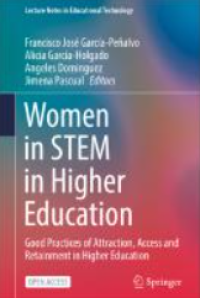
Text
E-book Women in STEM in Higher Education : Good Practices of Attraction, Access and Retainment in Higher Education
Penilaian
0,0
dari 5Women present a historic and worrying gap in science and technology-related disciplines, generally knowns as STEM (Science, Technology, Engineering,and Mathematics), except in the case of health professions. A holistic approach isneeded to support policymakers worldwide in bridging the gender gap in STEM, inwhich higher education institutions have a crucial role. Promoting this active impli-cation of the universities in this problem, in the European project Building the futureof Latin America: engaging women into STEM (W-STEM), a model to modernisethe government, management and operation of higher education institutions in LatinAmerica to improve attraction, access to and retention of women in STEM programshas been developed. This situation is not exclusive to Latin American countries, itis a global problem, so the results of the W-STEM project are also applicable toEuropean partners and transferrable worldwide. The main goal of this chapter isto describe the W-STEM model based on three years of working on strategies andmechanisms to improve the attraction, access, guidance, and retention processes toengage more women in STEM programs. The model has been thoroughly tested ineleven institutions in Chile, Colombia, Costa Rica, Ecuador, and Mexico, involvingpublic and private institutions with different gender equality situations. Genderequalityreferstotheequalrights,responsibilitiesandopportunitiesofwomenand men and girls and boys. This means that women’s and men’s rights, responsi-bilities and opportunities will not depend on whether they are born male or female(OSAGI,2021). It is goal 5 in the 2030 agenda for Sustainable Development, butalso gender equality cuts across all 17 Sustainable Development Goals (SDG) and isreflected in 45 targets and 54 indicators for the SDGs (Dugarova,2019; Inter-Agencyand Expert Group on SDG Indicators,2017; Pradhan et al.,2017). Gender equality isalso part of the European Union (EU) policies so that gender equality and women’sempowerment are promoted and financially supported worldwide.Higher Education Institutions (HEI) have a major role in contributing to the SDGs,not only in their internal policies but also in preparing students for the challenges ofthe twenty-first century. HEIs are a key element to ensure the sustainability of theSDGs. Besides goal 4, ensure inclusive and equitable quality education and promotelifelong learning opportunities for all, HEIs define processes and actions related topoverty (SDG 1), health and well-being (SDG 3), gender equality (SDG 5) or climatechange (SDG13), among others.According to the Global Gender Gap Report, no country has yet to achieve fullgender parity. The Global Gender gap score in 2021 is 67.7%, which means thatthe remaining gap to close stands at 32.3% (World Economic Forum,2021). Thisindex measures the gender-based differences in four key dimensions and tracks thenarrowing of these gaps over time: economic participation and opportunity, educa-tional attainment, health and survival and political empowerment. Each subindexprovides a score related to gender parity. In particular, 95% of educational attainmentgaps have been closed already. However, there are gender gaps in higher educationworldwide, although the enrolment rates in tertiary education achieved full genderparity in most of the countries (UIS. Stat,2016).Women are persistently underrepresented in science, technology, engineering,and mathematics (STEM) (Directorate-General for Research and InnovationHorizon,2020; OECD,2015; Tomassini,2021; UNESCO,2007; UNESCO Institutefor Statistics,2018). Although most countries have more women than men enrolledin tertiary education, the number of women in tertiary education who choose STEMis around 15% (UNESCO. Director-General 2009–2017,2017). For example, only13.76% of women in tertiary education choose STEM compared to 35.12% of menin Colombia (0.39 gender gap score). The situation is worst in Spain, with a gendergap score of 0.33, Finland with 0.25 or Ireland with 0.38.The STEM labour force is a fundamental tool for responding to the needs oftwenty-first- century society; it has a crucial role in sustainable development. More-over, market forces are transforming industries (World Economic Forum,2016), notonly in favour of technology skills development, but also the need for STEM skillssuch as critical thinking, problem-solving or innovation (World Economic Forum,2020). Besides the lack of women in STEM, there is also a lack of workers to fill theneeds of the STEM labour force.
Ketersediaan
Informasi Detail
- Judul Seri
-
-
- No. Panggil
-
607.1 GAR w
- Penerbit
- Singapore : Springer Nature., 2022
- Deskripsi Fisik
-
204 hlm
- Bahasa
-
English
- ISBN/ISSN
-
9789811915529
- Klasifikasi
-
607.1
- Tipe Isi
-
text
- Tipe Media
-
computer
- Tipe Pembawa
-
online resource
- Edisi
-
-
- Subjek
- Info Detail Spesifik
-
-
- Pernyataan Tanggungjawab
-
-
Versi lain/terkait
Tidak tersedia versi lain
Lampiran Berkas
Komentar
Anda harus masuk sebelum memberikan komentar
 Karya Umum
Karya Umum  Filsafat
Filsafat  Agama
Agama  Ilmu-ilmu Sosial
Ilmu-ilmu Sosial  Bahasa
Bahasa  Ilmu-ilmu Murni
Ilmu-ilmu Murni  Ilmu-ilmu Terapan
Ilmu-ilmu Terapan  Kesenian, Hiburan, dan Olahraga
Kesenian, Hiburan, dan Olahraga  Kesusastraan
Kesusastraan  Geografi dan Sejarah
Geografi dan Sejarah